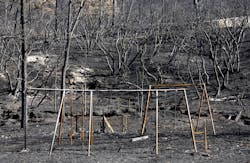Access to social media and cell phones in rural areas makes it difficult for fire officials to warn residents about approaching wildfires.
This was just one of the findings in a NFPA study Wildland/Urban Interface: Fire Department Wildfire Preparedness and Readiness Capabilities.
"The purpose of this pilot study is to review and assess the current preparedness and readiness levels of local wildland/urban interface (WUI) fire departments that have experienced a significant wildfire event in recent years," researchers wrote.
They based the document after interviews with 46 fire chief and senior line officers, who relayed information about departments are addressing the wildfire peril and making the transition to becoming better prepared and ready to control and mitigate a wildfire incident in their communities.
For some departments these conditions require only minor adjustments in their organization, procedures, and activities, while for other departments a major shift in outlook and approach may be required, they determined.
Key findings include:
- WUI/Wildland Fire Equipment: Departments often manage budgetary limitations by choosing apparatus that could be used for a variety of different purposes, and by strategic dispatching to maximize the effectiveness of the resources they have.
- Training: Urban, rural and volunteer fire departments increasingly co-manage fire in the WUI. Wildland firefighter training, although separate from traditional (structural) firefighting training, is increasingly sought after for the modern fire department.
- Communicating with the Public: Access to social media, the internet and cell phones in rural areas is often limited, making communication between residents and fire departments increasingly challenging.
- Community Risk Reduction Efforts: While homeowners in some communities rely too heavily on fire departments to take charge of fuel reduction projects, others want little to no involvement from outside agencies when it comes to managing the vegetation on their private property. This makes it difficult for departments to engage homeowners in collaborative mitigation efforts.
- Relationship Building and Cooperation: Inadequate funding and personnel dedicated to mitigation planning and implementation is an issue for some departments. Lack of involvement in national preventative programs like Fire and Fire Adapted Communities which provide an avenue for state and federal grants, educational materials and learning networks, is another likely impediment to relationship building and cooperative planning.
Researchers also pointed out:
- 54% of the rural fire departments and 75% of the urban fire departments have a firefighter fitness program, of those only 48% of the rural fire departments and 59% of the urban fire departments use the National Wildfire Coordinating Group (NWCG) physical fitness test for wildland firefighters “pack” test.
- 85% use chainsaws in a wildland fire event, of those only 44% of the fire departments have had all their personnel formally trained in wildland fire chainsaw operation and 8% of the fire departments provide no formal training. Of those who use chainsaws in a wildfire event 82% are equipped with ALL the appropriate personal protection equipment (PPE). 8% had no PPE. Of those who use chainsaws only 54% of the swampers (chainsaw helpers) wear the same PPE as the chainsaw operator.
- All believe that collaboration with other emergency response organizations is extremely important in protecting your community against wildfire






